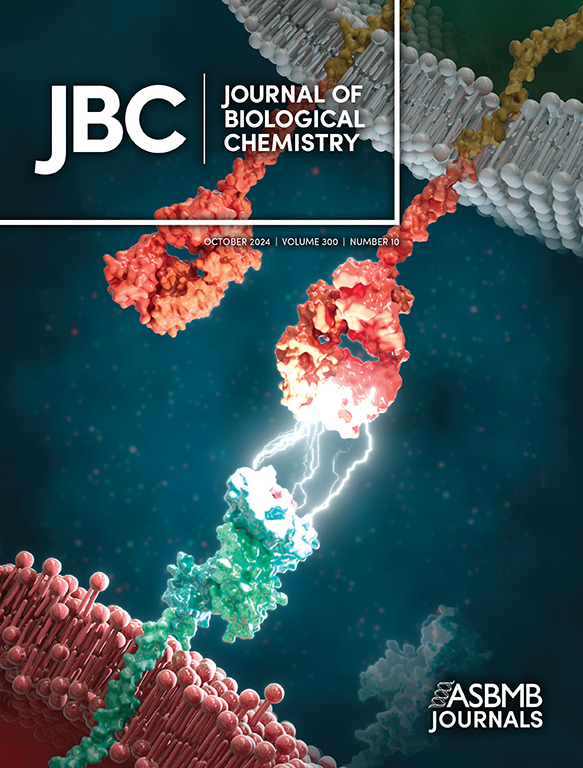Maintenance of proper phosphatidylinositol-4-phosphate level by Stt4 and Sac1 contributes to vesicular transport to and from the plasma membrane
IF 4
2区 生物学
Q2 BIOCHEMISTRY & MOLECULAR BIOLOGY
引用次数: 0
Abstract
Growing evidence suggests that counter-transport of phosphatidylinositol-4-phosphate (PtdIns(4)P) and phosphatidylserine (PS) at endoplasmic reticulum (ER)-plasma membrane (PM) contact sites is required for intracellular vesicle transport. PtdIns(4)P is metabolized by Stt4 PI 4-kinase residing at the PM and by Sac1 PtdIns(4)P phosphatase at the ER, and ER-PM contact sites are believed to be important for its efficient turnover. Recently, Stt4 has been shown to extensively localize to ER-PM contact sites. However, the precise location of Stt4 and the mechanism of localization to these sites have not been clarified. Additionally, although several studies have suggested a requirement for PS/PtdIns(4)P and sterol/PtdIns(4)P exchange at ER-PM contact sites in endocytosis, it is still unclear whether contact between the ER and PM, turnover of PtdIns(4)P or PS, or maintenance of PtdIns(4)P or PS levels is more important. Here we found that Stt4 localizes to the cER regions where Scs2 and Ist2 are localized abundantly, and that localization of Stt4 is maintained in the Δtether mutant, which has a reduced number of ER-PM contact sites. We also demonstrated that the Δtether and通过Stt4和Sac1维持适当的磷脂酰肌醇-4-磷酸水平有助于进出质膜的囊泡运输
越来越多的证据表明,磷脂酰肌醇-4-磷酸(PtdIns(4)P)和磷脂酰丝氨酸(PS)在内质网(ER)-质膜(PM)接触部位的反运输是细胞内囊泡运输所必需的。PtdIns(4)P由位于PM的Stt4 PI 4-激酶和内质网的Sac1 PtdIns(4)P磷酸酶代谢,ER-PM的接触位点被认为是其有效周转的重要因素。最近,st4已被证明广泛定位于ER-PM接触点。然而,Stt4的确切位置和定位到这些位点的机制尚不清楚。此外,尽管有几项研究表明,在内吞作用中,ER-PM接触部位需要PS/PtdIns(4)P和甾醇/PtdIns(4)P交换,但仍不清楚ER和PM之间的接触、PtdIns(4)P或PS的转换,或维持PtdIns(4)P或PS水平是否更重要。在这里,我们发现Stt4定位于Scs2和Ist2丰富定位的cER区域,并且Stt4的定位在Δtether突变体中保持,该突变体的ER-PM接触位点数量减少。我们还证明Δtether和sac1Δ突变体在不同的内吞作用阶段表现出缺陷,Stt4的失活突变仅在Δtether突变体中恢复了内吞作用缺陷。此外,这些突变体在分泌和再循环途径中表现出运输缺陷,Stt4的失活恢复了Δtether突变体的分泌途径,但没有恢复两个突变体的再循环途径。这些结果表明,内吞、分泌和循环途径是由不同的PtdIns(4) p介导机制直接或间接调节的。
本文章由计算机程序翻译,如有差异,请以英文原文为准。
求助全文
约1分钟内获得全文
求助全文
来源期刊

Journal of Biological Chemistry
Biochemistry, Genetics and Molecular Biology-Biochemistry
自引率
4.20%
发文量
1233
期刊介绍:
The Journal of Biological Chemistry welcomes high-quality science that seeks to elucidate the molecular and cellular basis of biological processes. Papers published in JBC can therefore fall under the umbrellas of not only biological chemistry, chemical biology, or biochemistry, but also allied disciplines such as biophysics, systems biology, RNA biology, immunology, microbiology, neurobiology, epigenetics, computational biology, ’omics, and many more. The outcome of our focus on papers that contribute novel and important mechanistic insights, rather than on a particular topic area, is that JBC is truly a melting pot for scientists across disciplines. In addition, JBC welcomes papers that describe methods that will help scientists push their biochemical inquiries forward and resources that will be of use to the research community.
 求助内容:
求助内容: 应助结果提醒方式:
应助结果提醒方式:


